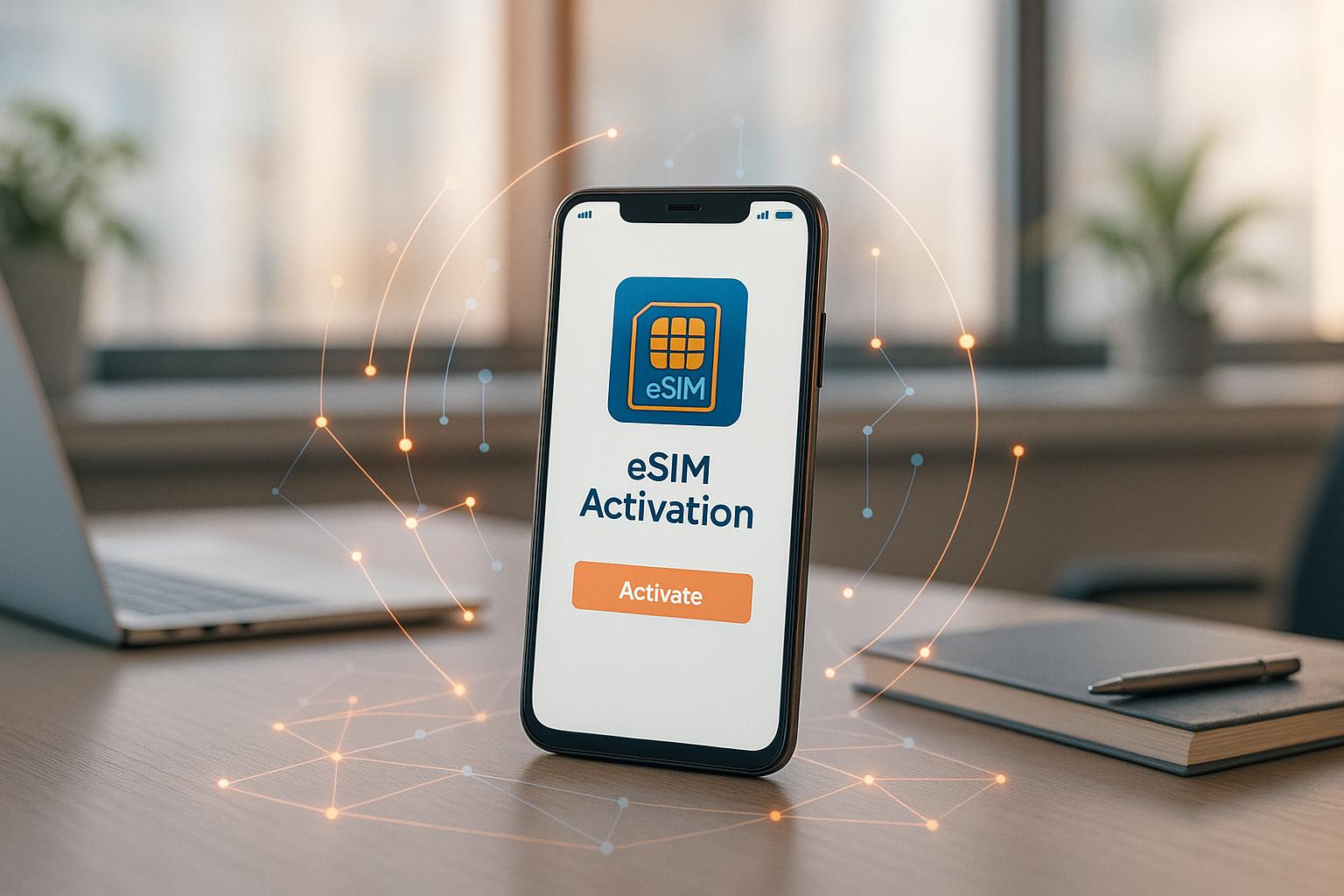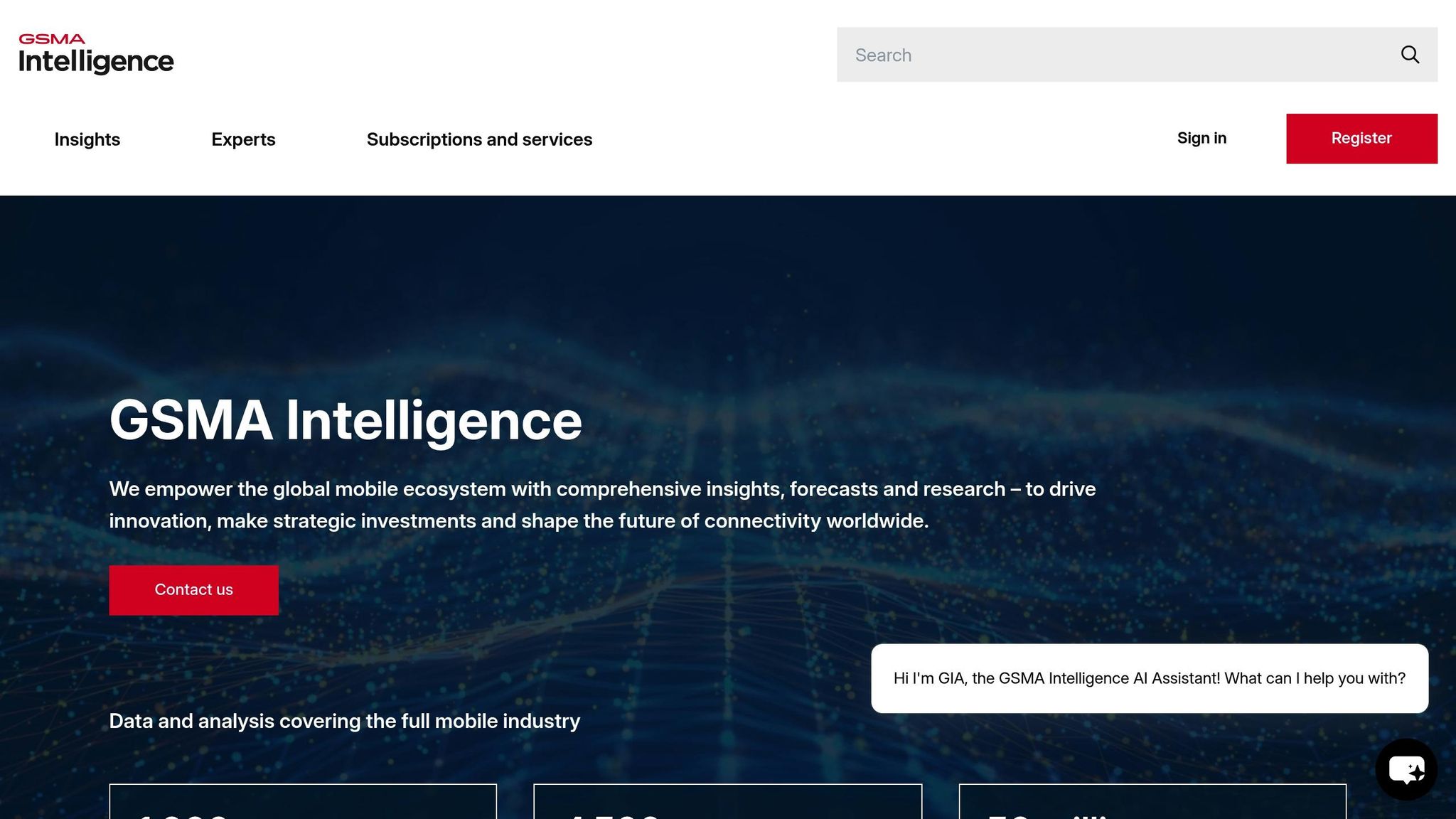Checklist for Scaling Business Telecom with eSIM
https://www.zimconnections.com/checklist-for-scaling-business-telecom-with-esim/
 SHARE
SHARE
eSIM technology is reshaping how businesses manage telecom operations. By removing physical SIM cards, it simplifies device connectivity, reduces costs, and offers remote management capabilities. This makes it particularly effective for businesses operating across multiple locations or expanding internationally. Here’s a quick breakdown of the key steps to scale your business telecom with eSIM:
- Verify Device Compatibility: Ensure your devices support eSIMs by checking for an EID and confirming they are carrier-unlocked.
- Follow Regulatory Requirements: Comply with telecom regulations, secure necessary digital certificates, and stay updated on regional standards.
- Choose a Reliable eSIM Provider: Evaluate providers based on coverage, pricing, scalability, and API integration features.
- Prepare Teams and Processes: Train staff on eSIM management, standardise procedures, and collaborate with key stakeholders.
- Plan for Growth: Use tools like bulk provisioning, monitor performance metrics, and budget for technology updates.
This structured approach ensures efficient telecom scaling while keeping costs and complexities under control.
MWC23 Barcelona – eSIM Summit: Scaling eSIM in 2023 and beyond – GSMA Intelligence

Step 1: Check Device and Infrastructure Compatibility
Making sure your devices support eSIM technology is the first step to a smooth rollout. Verifying compatibility upfront helps you avoid unnecessary disruptions.
Verify Device eSIM Support
The key to confirming eSIM support is identifying the Embedded Identity Document (EID) – a unique 32-digit identifier that indicates the presence of an eSIM chip.
Here’s how to check for eSIM compatibility based on device type:
- iPhone and iPad: Open the phone app and dial *#06#. If the EID appears, the device supports eSIM. Alternatively, go to Settings > General > About to locate the EID.
- Android devices: Dial *#06# to check for the EID. If it shows up, the device is eSIM-capable. You can also go to Settings > About phone and look under the device details section. Tap ‘Tap to show info’ to view the EID and QR code.
- Samsung Galaxy: Navigate to Settings > Connections > SIM Manager. If you see the option to ‘Add eSIM’, the device supports eSIM.
- Google Pixel: Go to Settings > Network & Internet and tap the “+” next to SIMs. If you see ‘Download a SIM instead?’, your device is eSIM-compatible.
Check for Carrier Lock
Ensure the device is carrier-unlocked. For iPhones, go to Settings > General > About and check the “Carrier Lock” status. If it says “No SIM restrictions”, the device is unlocked. On Android, remove the current SIM card, insert one from a different carrier, and try making a call. If the call connects, the device is unlocked.
Important Note:
Not all devices from the same manufacturer will support eSIM. Even if a model is generally listed as eSIM-capable, certain regional variants or carrier-specific customisations might disable this feature. If you’re unsure, reach out to the device manufacturer, vendor, or your carrier for confirmation.
Step 2: Meet Regulatory Requirements
Navigating telecom regulations is no small task. These rules differ widely across regions, and failing to comply can lead to hefty fines or even interruptions in service. Laying out a solid regulatory framework early on is crucial for protecting your business and ensuring a smooth eSIM rollout.
Review Telecom Compliance Standards
At the heart of eSIM compliance is the GSMA eSIM Remote SIM Provisioning Architecture. This global framework outlines how eSIM profiles are securely downloaded, installed, and managed across devices and networks.
Key areas to focus on include:
- Data Protection: Regulations like GDPR in the UK and EU dictate how customer data is collected, stored, and processed during eSIM activation.
- Network Security: Encrypted communication channels are essential for secure interactions between your systems and eSIM platforms.
- Device Certification: Your hardware must meet the standards set by local telecom authorities.
For businesses in the UK, Ofcom regulations cover critical areas such as consumer protection, emergency service access, and number portability. If you’re working internationally, you’ll need to ensure compliance with the telecom standards specific to each region.
Some industries face additional layers of regulation. For example, healthcare organisations must comply with standards like HIPAA in the US or NHS Digital requirements in the UK when handling patient data. Meanwhile, financial services must meet PCI DSS requirements for secure payment processing and data protection.
Once you’ve mapped out these compliance needs, the next step is acquiring the necessary digital certificates.
Get Required Digital Certificates
Digital certificates play a vital role in eSIM authentication and regulatory compliance. They ensure secure communication and establish trust between your devices, systems, and network operators. Here’s what you’ll need:
- eUICC Certificates: These are the main identifiers for your eSIM-enabled devices.
- SM-DP+ Certificates: These facilitate secure profile downloads from subscription manager platforms.
- Root Certificate Authority (CA) Certificates: These create a chain of trust between your organisation, device manufacturers, and mobile operators.
To obtain these certificates, you’ll need to submit documentation such as your company registration, telecom licences, and infrastructure details. Automating certificate renewals is a smart move to avoid disruptions. Extended Validation (EV) certificates, while requiring more rigorous verification, offer a higher level of trust – especially important for large-scale eSIM deployments.
Many organisations rely on certificate management platforms to handle renewals, track expiration dates, and manage certificates across various regions.
Track Regulation Changes
The telecom industry is constantly evolving, especially with emerging technologies like eSIM. Staying up to date with regulatory changes is essential. Bodies like the European Telecommunications Standards Institute (ETSI) frequently update standards as national policies shift to address market and security developments.
To stay informed:
- Use regulatory alert services to track updates from organisations like GSMA and ETSI. The GSMA, in particular, is a valuable resource for the latest on eSIM standards and regulatory changes.
- Brexit has added another layer of complexity for UK businesses operating in the EU. Post-Brexit, you may need separate compliance frameworks for EU operations, including distinct data protection and telecom licensing requirements.
- Set up automated alerts for keywords like “eSIM”, “mobile virtual network”, or “telecommunications licensing” to flag relevant updates quickly.
Step 3: Select and Set Up eSIM Provider
After verifying your devices and ensuring compliance, the next step is choosing the right eSIM provider. This decision is a cornerstone for scaling your business, as it directly influences both operational costs and customer satisfaction. With the global eSIM market expected to exceed £12.8 billion by 2027, it’s clear that the demand for flexible digital connectivity is only growing.
Compare Provider Plans
The success of your eSIM deployment hinges on selecting a provider whose plans align with your current needs and long-term goals. Start by analysing your mobile connectivity requirements, both now and in the future.
Coverage and Network Quality should be at the top of your checklist. Choose a provider with a strong global presence and reliable network partnerships. It’s not just about the number of countries covered – it’s about the quality of service. Features like local breakout can significantly improve latency and connection speeds.
Pricing Structure is another key factor. Compare costs such as price per GB, activation fees, and recurring charges. If you plan to resell services, consider the profit margins each pricing model offers. Transparent, tiered pricing – whether pay-as-you-go, monthly plans, or data-only options – can help you manage costs effectively.
For businesses with international connectivity needs, ZIM Connections is a noteworthy option. They provide comprehensive eSIM plans that cover over 200 destinations, offering 5G/4G internet, unlimited data options, and even local phone numbers. This flexibility allows businesses to stay connected across multiple regions with a single eSIM, simplifying operations and potentially cutting costs.
To make an informed choice, review the provider’s coverage map and partnerships with local operators. Customer reviews and case studies can provide valuable insights into real-world performance. Once you’ve selected a plan, the next step is integrating with the provider’s system.
Connect Provider APIs
API integration is critical for smooth operations. A well-documented API that supports bulk provisioning and standard operations will make it easier to integrate with your existing IT systems.
Integration Capabilities should align with your IT infrastructure. Check that the API supports the programming languages and frameworks your team uses. If branding consistency is crucial, white-label options can be especially helpful.
Bulk Management Features are essential as your business grows. The API should handle large-scale operations effortlessly, allowing you to manage hundreds or even thousands of eSIM profiles without performance issues. Real-time status updates and robust error-handling mechanisms are also vital.
Training your IT team on eSIM activation and management is crucial to maximising the solution’s potential. Many providers offer technical training or certification programmes to enhance your team’s expertise.
Security and Authentication should meet enterprise-grade standards. Look for APIs that offer secure authentication methods, encrypted data transmission, and detailed audit logs – especially important for businesses in regulated industries.
Once the API integration is complete, you’ll need to evaluate how the provider supports your business as it scales.
Check Growth Support Options
Ensure the provider can scale alongside your business and adapt to your evolving needs.
Scalability Infrastructure is essential for handling increased activations and data usage. Ask about their network capacity, redundancy measures, and how they’ve performed during peak usage periods. Providers investing in cutting-edge eSIM technologies are better positioned to support long-term growth.
Customer Support Quality becomes increasingly vital as your operations expand. Evaluate their responsiveness across channels like email, phone, and live chat. Comprehensive documentation, FAQs, and tutorials can empower your team to troubleshoot independently, reducing reliance on external support.
Reporting and Analytics Capabilities are invaluable for tracking usage patterns, activations, and performance metrics. Access to detailed analytics can help you understand customer behaviour and refine your offerings as your business grows.
Flexible Plan Adjustments allow you to adapt quickly to changing needs. Look for providers that make it easy to modify plans, increase capacity temporarily, or adjust for seasonal fluctuations – features that are particularly useful for businesses with variable connectivity demands.
Finally, pay close attention to Contract Terms, including duration, termination clauses, and any associated fees. Avoid long-term agreements that limit your flexibility. Providers offering trial periods or pilot programmes give you the chance to test their services before committing.
sbb-itb-273ea09
Step 4: Prepare Teams and Processes
Once you’ve chosen and integrated your eSIM provider, the next step is to prepare your teams and establish solid processes. This groundwork is key to ensuring smooth deployment and effective management of your eSIM infrastructure. By getting this stage right, you can avoid costly interruptions and set yourself up for growth.
Train Staff on eSIM Basics
Your team’s understanding of eSIM technology is critical for a successful roll-out. Training sessions should cover the essentials, such as how eSIMs work, the remote provisioning process, and security protocols. Keeping your team informed about the latest industry updates and security measures is equally important.
Customise Training for Different Roles within your organisation. For example:
- The sales team needs to grasp the benefits and limitations of eSIMs so they can explain them to customers.
- Customer service representatives should be well-versed in activation procedures and troubleshooting common issues.
- The IT team requires in-depth knowledge of profile management and security protocols.
Highlight Security Awareness during training. Unlike traditional SIM cards, eSIMs bring new security challenges. Staff should know how to securely download profiles, recognise risks like unauthorised access, and handle customer data responsibly during provisioning.
Hands-On Practice is essential. Create a training environment where employees can practise tasks like activation, profile switching, and troubleshooting without impacting live accounts. This approach builds confidence and helps identify potential issues early.
To reinforce learning, provide clear documentation. Include step-by-step guides, error codes, and escalation processes, so staff have reliable resources to consult during their daily tasks.
Once training is complete, move on to creating standardised procedures for consistent operations.
Create Standard Procedures
Standardising procedures is essential for maintaining consistency and reducing errors, especially as your business scales. Your processes should cover the entire eSIM lifecycle, including provisioning, activation, switching, deactivation, and profile deletion.
A Centralised Management Platform is crucial for managing eSIM profiles at scale. This platform provides visibility and control over the entire lifecycle. Clearly define who can access this platform and under what conditions.
Update Inventory Management practices to reflect the complexities of eSIMs. Unlike traditional SIM cards, a single device can hold multiple numbers, plans, and carrier relationships. Develop procedures to track available profiles and active subscriptions accurately.
Address Carrier Relationships in your standard operating procedures. Managing multiple carrier contracts and dynamically allocating eSIMs can add complexity. Define clear processes for negotiating terms, approving new carrier partnerships, and escalating service issues.
Device Lifecycle Management should also be included. Outline steps for reassigning profiles when devices are replaced, ensuring security during transfers, and deactivating profiles when devices are retired.
To maintain high standards, introduce quality checkpoints. Set metrics for successful activations, acceptable response times, and customer satisfaction. Regular audits will help ensure your procedures remain effective as your operations grow.
The next step is to collaborate with key partners to support these processes.
Work with Key Partners
Scaling your eSIM operations depends on strong partnerships with both internal teams and external stakeholders.
Identify Key Partners early on. These might include Mobile Network Operators (MNOs), device manufacturers (OEMs/ODMs), eSIM management providers, and other service vendors. Don’t forget your internal IT team – they’re vital players in this ecosystem.
Focus on Security Collaboration with your partners. Work together to develop robust security measures by sharing best practices, conducting joint research, and participating in industry initiatives. This collaborative approach can help establish shared security standards.
Manage Vulnerabilities Proactively by teaming up with partners to identify and address potential risks. Regular security reviews and collective analysis ensure your eSIM deployment stays protected against new threats.
Seek Technical Integration Support from device manufacturers and system integrators. Clear communication channels and well-defined support expectations – such as response times and escalation procedures – can significantly speed up deployment.
Share Knowledge through agreements with partners. These can provide insights into industry trends and emerging technologies. Participating in consortiums or user groups can also be a valuable way to learn from others’ experiences and share your own.
To keep partnerships aligned with your goals, conduct quarterly reviews to monitor performance and ensure everyone stays on track.
Step 5: Plan for Business Growth
Once your teams are trained and processes are running smoothly, it’s time to scale your eSIM deployment. The challenge lies in expanding your infrastructure without straining performance or overshooting your budget. The solution? Implement systems that can handle increased demands while staying efficient.
Use Bulk Device Setup
When rolling out large-scale deployments, batch provisioning is your best friend. This method allows you to configure multiple devices at once, cutting down on deployment time and reducing the chances of human error.
Automated provisioning systems play a key role here. These systems pre-configure eSIM profiles before devices even reach the end user, ensuring they’re ready to connect as soon as they’re powered on. Tasks like profile downloads, carrier selection, and initial network authentication are handled automatically, removing the need for manual input.
To streamline the process further, use template-based configurations. For example, create standard profiles tailored to specific groups – like sales teams, field engineers, or international travellers. Each profile can include specific data plans, regional coverage, and security settings, ensuring consistent and efficient deployment.
Phased deployment is another smart strategy to manage risks. Instead of activating all devices at once, roll them out in stages. This approach allows you to spot and fix potential issues, such as connectivity problems or activation errors, before they escalate across your entire fleet.
For businesses operating in multiple regions, geographical batching can be especially effective. Group devices by location to optimise carrier selection and cut down on roaming costs. Providers like ZIM Connections simplify this process with global plans that offer coverage in over 125 countries, making multi-region deployments far less complicated.
Before scaling up, test a sample of devices from each batch. This ensures that activation, connectivity, and profile integrity are functioning as expected. Once everything is set up, keep a close eye on performance metrics to ensure your deployment is running smoothly.
Track Key Performance Data
Scaling successfully means keeping a constant pulse on your eSIM infrastructure’s performance. By using data to guide your decisions, you can spot bottlenecks early and ensure your investment is delivering the results you need.
Key metrics to monitor include:
- Connectivity: Track connection success rates, network switching frequency, and data usage patterns.
- Cost Analysis: Evaluate total ownership costs, service fees, and operational expenses.
- User Experience: Measure activation times, profile switching success rates, and any connectivity issues.
- ROI: Assess both direct savings and indirect benefits.
- Performance Benchmarks: Compare your results against industry standards.
Automated reporting tools can make this process easier. Set up real-time dashboards that display these metrics and send alerts for any performance issues. This way, stakeholders stay informed without overloading your IT team, freeing them up to focus on strategic improvements.
Accurate performance tracking also helps you identify when and where technology updates are needed to keep your deployment future-ready.
Plan for Technology Updates
As eSIM technology evolves, staying ahead of updates is crucial. New standards, improved security protocols, and enhanced device capabilities are introduced regularly, and your systems need to keep pace.
Start by keeping an eye on GSMA updates. The GSMA frequently revises eSIM specifications, adding new features and strengthening security. Stay informed by following industry publications and updates from your provider.
Device lifecycle management is another area to consider. Unlike traditional SIM cards, eSIM profiles can be transferred between compatible devices, extending their usability. Develop policies for profile migration during device upgrades to ensure smooth transitions and maximise your investment.
Security is also a moving target. Regularly update digital certificates and encryption protocols to protect against evolving threats. Build relationships with security vendors and participate in industry initiatives to stay ahead of potential risks.
Don’t forget about carrier network improvements. Mobile operators are constantly upgrading their networks, whether it’s expanding 5G coverage or boosting data speeds. Monitoring these changes allows you to adjust carrier partnerships and take advantage of better performance. Platforms like ZIM Connections make this easier by supporting multiple carriers, so you can benefit from upgrades without switching providers.
As your business systems evolve, reassess integration capabilities. New tools like CRM systems or inventory management platforms might offer better eSIM integration features. Plan these updates during maintenance windows to minimise disruptions.
Finally, budget planning is essential. Allocate a portion of your eSIM budget for regular technology updates, so you can adopt improvements without derailing your operations. Stay in touch with your provider to understand their future plans. This collaboration can help you align your strategy with upcoming features and opportunities for early adoption.
Key Points for eSIM Business Scaling
Scaling telecom operations with eSIM technology demands a well-planned approach that addresses every aspect of implementation and growth. Here’s a recap of the essential steps covered earlier.
Careful preparation is key. Ensuring device compatibility, robust infrastructure, and adherence to regulatory requirements can prevent costly mistakes during the rollout process, as highlighted in Steps 1–4.
Choosing the right provider and preparing your team are crucial for maximising eSIM’s potential. When your workforce is trained and workflows are optimised for eSIM, you can unlock benefits like improved security and remote provisioning. These advantages not only streamline device management but also reduce costs.
As your business grows, maintaining efficiency and controlling expenses becomes even more critical. Scalable bulk setups, proactive monitoring, and regular technology updates are essential strategies. With industry leaders like Apple and Google introducing eSIM-only devices, it’s clear that this technology is becoming the norm.
A reliable partner can make all the difference in scaling your connectivity needs. For example, ZIM Connections offers a comprehensive eSIM solution tailored for business growth. Their platform delivers coverage in over 200 destinations and provides flexible local, regional, and global plans. Features include 5G/4G connectivity, unlimited data, and local phone numbers – all managed through a single eSIM, simplifying multi-region operations.
Scaling with eSIM technology means aligning it with your business objectives. Whether you’re managing a distributed workforce, expanding internationally, or optimising telecom processes, a structured strategy ensures you take full advantage of eSIM’s capabilities while building a strong foundation for future growth.
FAQs
How can businesses comply with eSIM regulations in different regions?
To navigate eSIM regulations across different regions, businesses need to start by understanding the specific local requirements. These might include mandatory registration or verification procedures, which can vary significantly from one country to another. For instance, certain regions enforce stricter guidelines around user authentication and data protection.
Using globally recognised standards, such as the GSMA compliance framework, can be a smart move. This approach ensures security, functionality, and interoperability while aligning with regional rules. Developing a customised compliance plan that incorporates certifications and strong security protocols is crucial for reducing risks and achieving a smooth eSIM rollout in international markets.
What should businesses consider when choosing an eSIM provider for international operations?
When choosing an eSIM provider for international business, start by focusing on global coverage. This ensures your team stays connected no matter where they are operating. It’s also important to check for reliable network performance, the ability to switch between multiple networks, and simple activation processes to avoid unnecessary downtime.
Look for a provider that supports remote SIM provisioning and offers real-time management tools to help you stay in control of your telecom needs. Make sure their service is compatible with a variety of devices and offers flexible, budget-friendly plans with options for adaptable data and tariffs. These features will help ensure your operations remain both efficient and cost-effective.
How does eSIM technology benefit businesses compared to traditional SIM cards?
eSIM technology introduces a smarter way for businesses to handle their telecom requirements. Unlike traditional SIM cards, eSIMs can be activated remotely and allow instant profile changes, removing the hassle of physically swapping cards. This makes it far simpler to roll out devices and scale operations across different locations quickly.
Another major advantage is the reduction in roaming costs. With eSIMs, businesses can effortlessly switch between carriers to secure the best connectivity at competitive prices. They also enhance device management, offering a streamlined, cost-efficient way for companies to maintain global connectivity with ease.









































































































































































































